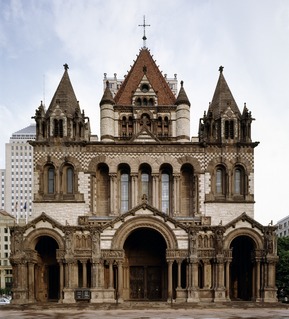
Daniel Chester French was an American sculptor of the late nineteenth and early twentieth centuries, best known for his design of the monumental statue of Abraham Lincoln (1920) in the Lincoln Memorial in Washington, D.C.

Richardsonian Romanesque is a style of Romanesque Revival architecture named after the architect Henry Hobson Richardson (1838–1886). The revival style incorporates 11th and 12th century southern French, Spanish, and Italian Romanesque characteristics. Richardson first used elements of the style in his Richardson Olmsted Complex in Buffalo, New York, designed in 1870. Multiple architects followed in this style in the late 1800s; Richardsonian Romanesque later influenced modern styles of architecture as well.

Henry Hobson Richardson was an American architect, best known for his work in a style that became known as Richardsonian Romanesque. Along with Louis Sullivan and Frank Lloyd Wright, Richardson is one of "the recognized trinity of American architecture".
The year 1886 in architecture involved some significant architectural events and new buildings.
Norcross Brothers Contractors and Builders was a nineteenth-century American construction company, especially noted for their work, mostly in stone, for the architectural firms of H.H. Richardson and McKim, Mead & White. The company was founded by James Atkinson and Orlando Whitney, who were contracted for their first project in 1869. In all, the company is credited with completing over 650 building projects.

The National Monument to the Forefathers, formerly known as the Pilgrim Monument, commemorates the Mayflower Pilgrims. Dedicated on August 1, 1889, it honors their ideals as later generally embraced by the United States. It is thought to be the world's largest solid granite monument.

Charles Howland Hammatt Billings (1818–1874) was an artist and architect from Boston, Massachusetts.

Shepley, Rutan and Coolidge was a successful architecture firm based in Boston, Massachusetts, operating between 1886 and 1915, with extensive commissions in monumental civic, religious, and collegiate architecture in the spirit and style of Henry Hobson Richardson.
Margaret Henderson Floyd was Professor of Architectural History at Tufts University. She was an expert on Boston architecture. Her writing includes several titles on the work of late 19th-century American architects including Henry Hobson Richardson, and Longfellow, Alden and Harlow.
George Thomas Tilden was an American architect active in Boston, Massachusetts.

The R. and F. Cheney Building, also known as the Brown Thomson Building, is a commercial building designed by noted American architect H. H. Richardson. It is located at 942 Main Street, Hartford, Connecticut, and is now on the National Register of Historic Places.

Longfellow, Alden & Harlow, of Boston, Massachusetts, and Pittsburgh, Pennsylvania, was the architectural firm of Alexander Wadsworth Longfellow Jr. (1854–1934), Frank Ellis Alden (1859–1908), and Alfred Branch Harlow (1857–1927). The firm, successors to H. H. Richardson, continued to provide structures in the Romanesque revival style established by Richardson that is often referred to as Richardsonian Romanesque.

The Boston Museum (1841–1903), also called the Boston Museum and Gallery of Fine Arts, was a theatre, wax museum, natural history museum, zoo, and art museum in 19th-century Boston, Massachusetts. Moses Kimball established the enterprise in 1841.
The Boston Artists' Association (1841–1851) was established in Boston, Massachusetts by Washington Allston, Henry Sargent, and other painters, sculptors, and architects, in order to organize exhibitions, a school, a workspace for members, and to promote art "for the art's sake."

The Federal Street Theatre (1793–1852), also known as the Boston Theatre, was located at the corner of Federal and Franklin streets in Boston, Massachusetts, United States. It was "the first building erected purposely for theatrical entertainments in the town of Boston."

Hartwell and Richardson was a Boston, Massachusetts architectural firm established in 1881, by Henry Walker Hartwell (1833–1919) and William Cummings Richardson (1854–1935). The firm contributed significantly to the current building stock and architecture of the greater Boston area. Many of its buildings are listed on the National Register of Historic Places.
Joseph Edward Billings was an architect in Boston, Massachusetts, in the mid-19th century. Among his business partners were his brother Hammatt Billings and Charles Frederick Sleeper. He served in the Massachusetts Volunteer Militia and belonged to the Boston Artists' Association.
Henry Augustus Sims was a Philadelphia architect of the 19th century.

Richard Bond (1798–1861) was an early American architect who practiced primarily in Boston, Massachusetts.
Cervin Robinson is an American photographer and author best known for architectural photography and historical writings that span his career, active from 1957 to the present.











